Spending 2 days in Phnom Penh might not be at the top of every traveler’s list when visiting Cambodia, but it absolutely should be. While the capital lacks the instant charm of Siem Reap or the cafe culture of other Southeast Asian cities, Phnom Penh is the heart of Cambodia’s modern history. This is where you’ll come face-to-face with the country’s tragic past, see its resilience firsthand, and discover a city that’s quietly but determinedly rebuilding itself. If you’re visiting Cambodia, taking time to understand its recent history is essential—and there’s no better place to do that than Phnom Penh.
Is Phnom Penh worth visiting
I’ll be honest – Phnom Penh is not the most exciting, or aesthetically pleasing city I’ve visited on my travels. It’s not particularly tourist friendly (at least compared to the gorgeous Siem Reap). It definitely feels like a city where modern Cambodians live and get on with their lives. So why visit?
Phnom Penh is the centre of Cambodia’s recent history, and the best place to understand the devastating impact of the Cambodian Genocide in the 1970s. No visitor to Cambodia should leave without fully understanding the impact of these very recent events, which still impact Cambodians today and have ever-greater resonance for the rest of the world. I visited in November 2024, and the experience has stayed with me, influencing the way I approach my travels in South East Asia.
How long do you need in Phnom Penh
Phnom Penh doesn’t offer a major tourist attraction like Siem Reap, and it doesn’t (yet) match the museums, cafe culture or historic architecture of cities like Hanoi, Penang or Singapore. People visit Phnom Penh primarily to understand Cambodia’s recent history. In this Phnom Penh guide, I suggest a two-day Phnom Penh itinerary, but if you’re short on time, you could fit the activities below into one packed day. There isn’t enough to do around Phnom Penh to visit for longer.
A brief history of modern Cambodia
During the 1970s, Cambodia was under the control of the Khmer Rouge, a Communist movement led by the infamous Pol Pot.
Between 1976 and 1978, Pol Pot and the Khmer Rouge orchestrated the Cambodian Genocide, killing up to 3 million people. While there are scars from these horrific events across Cambodia, the best places to visit to understand this appalling history are in Phnom Penh. Like Germany, Cambodia has invested in museums and monuments about the Cambodian Genocide, and two of the most comprehensive can be found in Phnom Penh.
I’m not an expert on Cambodian history, and there is so much that’s important, including the way Cambodian democracy has developed since the 1970s. For further understanding of Cambodia’s history since the end of the Khmer Rouge and into the 21st century, I recommend taking a walking tour with Martin (see below).
I also learn about history through reading well-researched novels. If you do too, check out these books about Southeast Asia, which includes one amazing novel about the history of Cambodia.
What to do in 2 days in Phnom Penh
Day 1: Understand Cambodia’s recent and ancient history, while eating fried tarantulas
Stop 1: Visit the Royal Palace
Cost: $10
You can’t miss the Royal Palace in Phnom Penh. This huge building takes up a lot of the waterfront, with huge portraits of the Cambodian Royal Family on display as well. Originally built in the 1860s and reconstructed in the early 20th century, it remains the official residence of the Cambodian royal family.
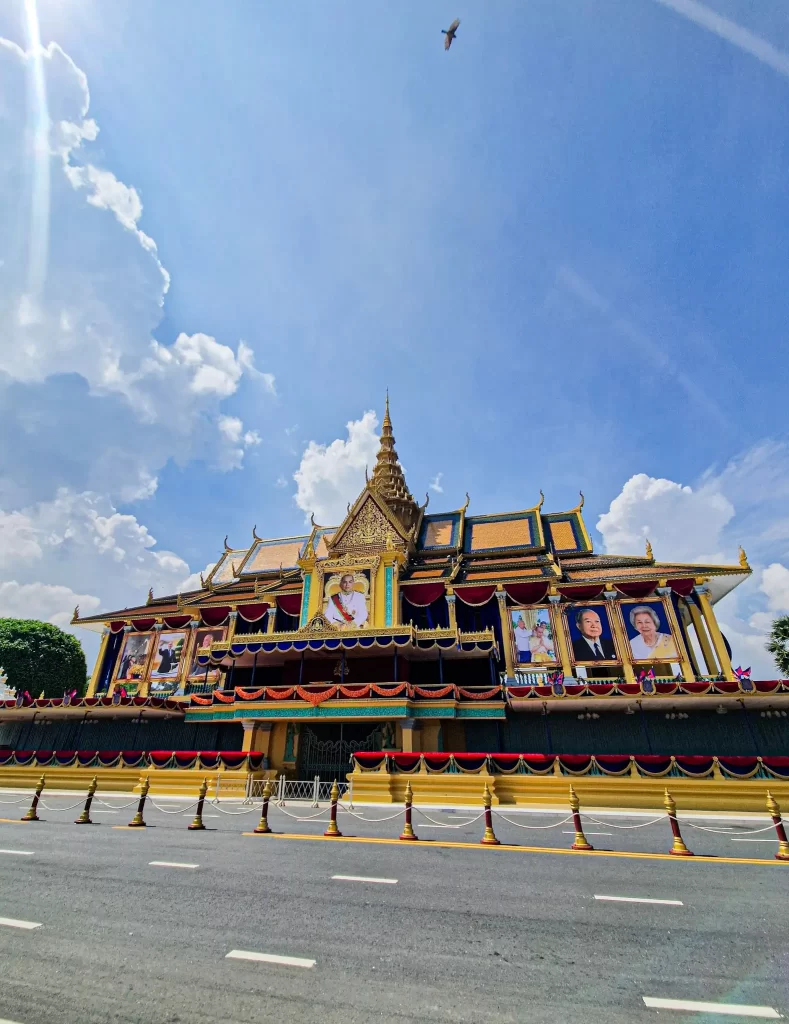
The most famous part of the palace to visit is the Silver Pagoda. It contains many treasures and a silver floor made of 5 tonnes of the precious metal.
To visit, note that you need to have shoulders and knees covered.
Top Tip: A common scam in Phnom Penh is tuk-tuk drivers meeting you in the square in front of the palace to tell you it’s closed. They then offer you a trip in their tuk-tuk to other sites in Phnom Penh. When this happened to me, I was unsure if the palace was truly closed—some online sources said it closed midday, while others indicated this policy had changed.
The best way to avoid the scam is ignoring the tuk-tuk drivers and walking to the entrance further down the street to find out for yourself. You can always walk back to the tuk-tuks if you decide you want the tour!
Stop 2: Visit Independence Monument
Cost: free
Cambodia’s Independence Monument was built in 1958 to symbolise Cambodia’s independence from France. It takes the form of a giant lotus-shaped stupa, and towers above the roads that surround it. While you won’t need to spend much time here, it’s an easy site to pass as you explore Phnom Penh.
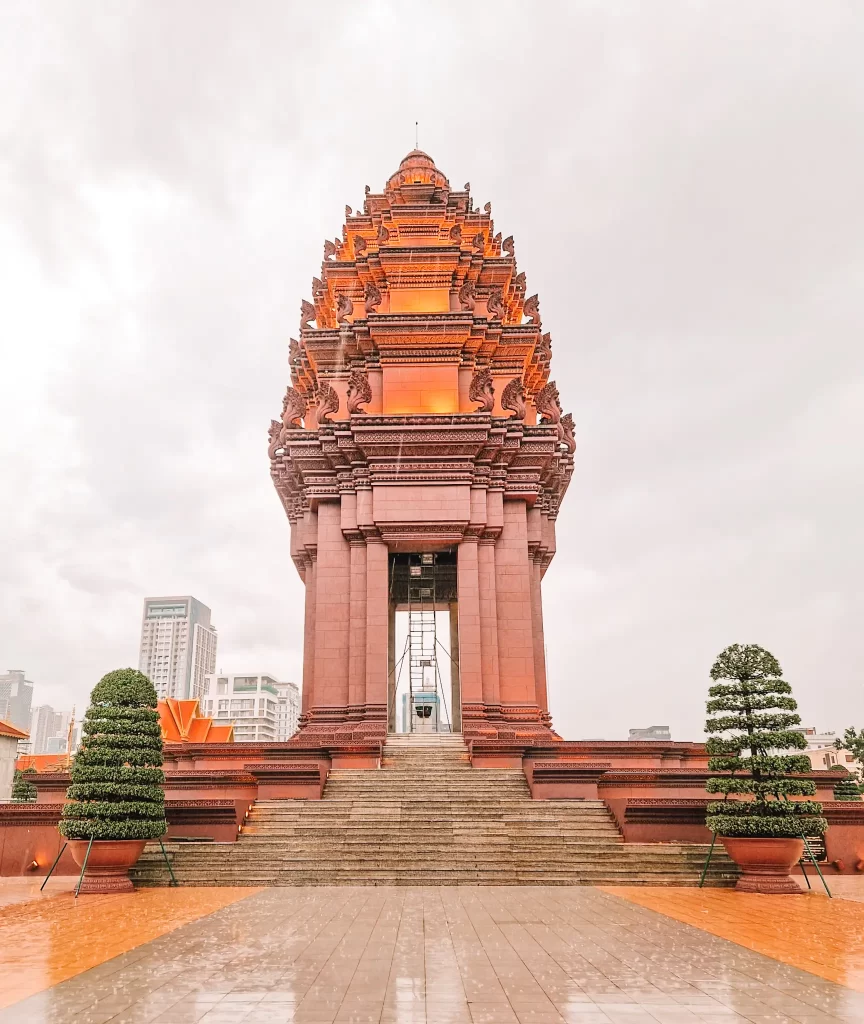
However, if you plan to take the walking tour below, you can skip this stop as this is the starting point for the tour.
Stop 3: Visit Wat Phnom Daun Penh
Cost: $1
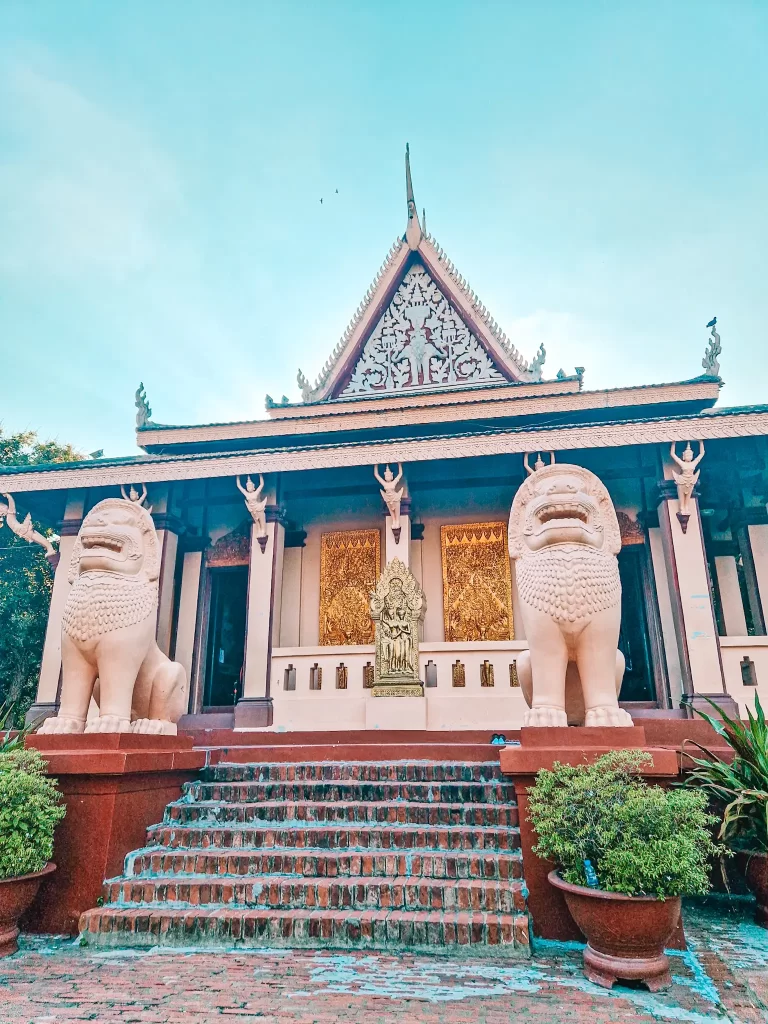
This is the most famous temple in Phnom Penh, and considered a sacred site for the country of Cambodia. Located at the far end of central Phnom Penh, it’s worth visiting during the day—though you’ll also see it at night on the walking tour below.
Founded in 1372, legend states that the temple was founded by Lady Penh, who gave the city her name. It’s on a hill, and to enter you climb a magnificent stairway before reaching the main pagoda. This remains an important site for Cambodians, and you’ll likely see people worshipping during your visit.
Stop 4: Take a walking tour of Cambodia’s history (and eat fried tarantulas)
Cost: varies
Part of the reason I’ve suggested a two day itinerary of Phnom Penh is that I recommend doing this walking tour before visiting the sites related to the Cambodian Genocide.
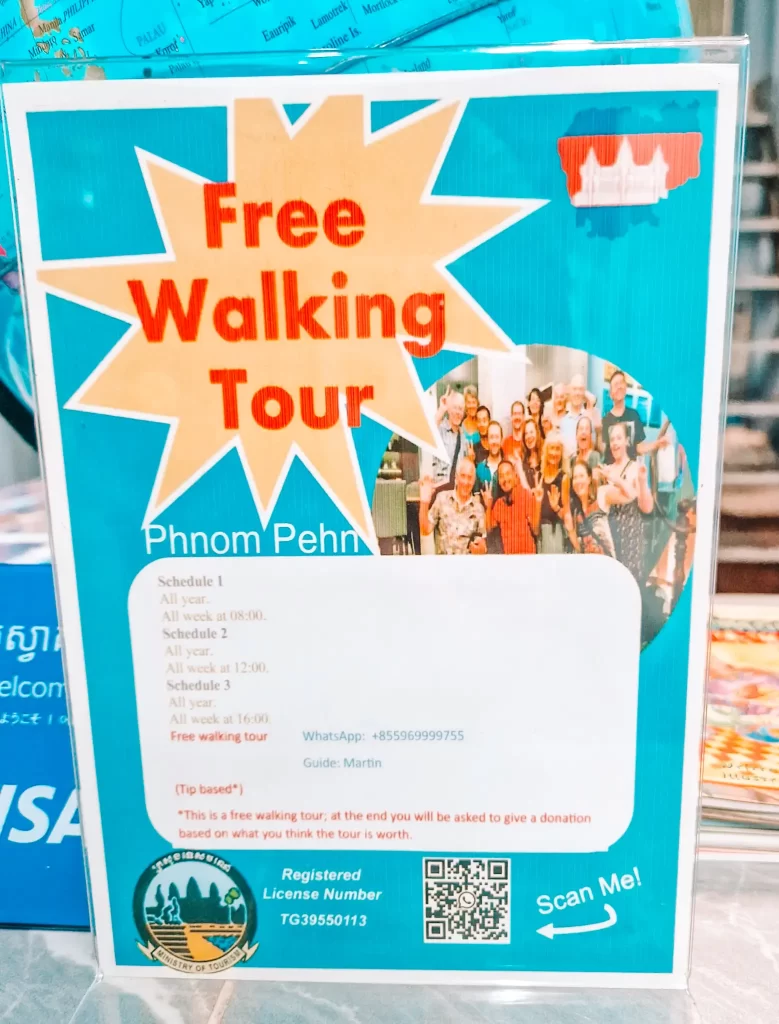
Run by an accredited Phnom Penh guide named Martin, the tour takes you to key sites in Phnom Penh. These include the Independence Monument, a Buddhist monastery, and Wat Phnom Daun Penh, which you will see in the dark.
Martin is passionate about Cambodian history, and at the start of the tour he gave us a rundown of recent Cambodian history. This started with the end of French colonisation in the 1950s, right up until the present day. I found this incredibly useful as background for understanding Tuol Sleng and Choeung Ek the following day.
On a lighter note, the tour also included a trip to Phnom Penh’s night market to try Cambodian specialities. Our first stop was to try fried tarantulas (too adventurous for me!) followed by bugs, and we moved on to easier options like coconut-based desserts.
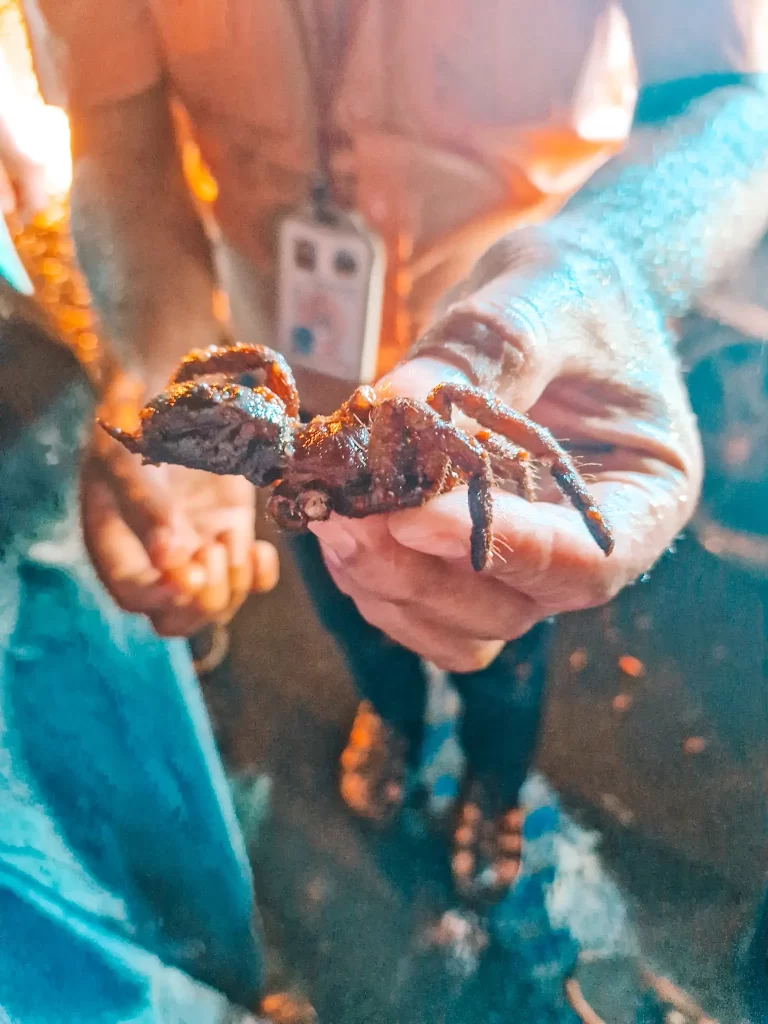
I can’t recommend this tour highly enough if you like history. It was a long walk – around 4 hours – but absolutely packed with information about Cambodia. You can book it on Get your Guide and pay up front, or you can join the tour and pay what you think it’s worth at the end. I’ve put the details below.
Stop 5: Try delicious Cambodian delicacies that aren’t spiders
If you haven’t eaten enough at the night market, you’ll definitely want dinner by the end of your walking tour. Try these highly rated options for a taste of traditional Khmer food:
- David’s Noodles. This delicious restaurant is bang in the middle of the tourist area of Phnom Penh. If you’re lucky, you’ll get to watch staff making the delicious fresh noodles in front of you!
- Kabbas restaurant – this Khmer cuisine restaurant was recommended by both my Tuol Sleng tour guide and by Martin on the walking tour as a great place to try local food.
Day 2: Understand the history and impact of the Cambodia Genocide
The second of your 2 days in Phnom Penh covers the most important sites in the city.
It’s hard, writing this Phnom Penh guide several months after visiting, to know what to say about these sites. The experience still feels very present and raw, and nothing I write will truly encompass the horror of the visits. One of the most difficult parts of the visit was understanding how much this is in living memory. Both victims and perpetrators of this violence are still alive in Cambodia today.
The two museums, Tuol Sleng Genocide Museum and Choeung Ek Genocidal Centre, are incredibly well set up and run, and are on the tentative list for UNESCO Heritage recognition.
I truly feel that any visitor to Cambodia should understand this history. They can be visited independently, with an audio guide, or as part of an organised tour with a guide. See my thoughts on each of these options below.
I have detailed some particular trigger warnings for each site below, but these visits are very difficult. Please take care of your mental health during and after your visit.
Stop 1: Choeung Ek Genocidal Centre
Cost: $3
Trigger warnings:
- Bones included as part of the museum and memorial
- Descriptions of violence, including agaisnt children
The first major Khmer Rouge site in Phnom Penh is the Choeung Ek Genocidal Centre, otherwise known as the Killing Fields. One of many mass graves around Cambodia, prisoners from facilities such as Tuol Sleng were transferred to the Killing Fields for execution.
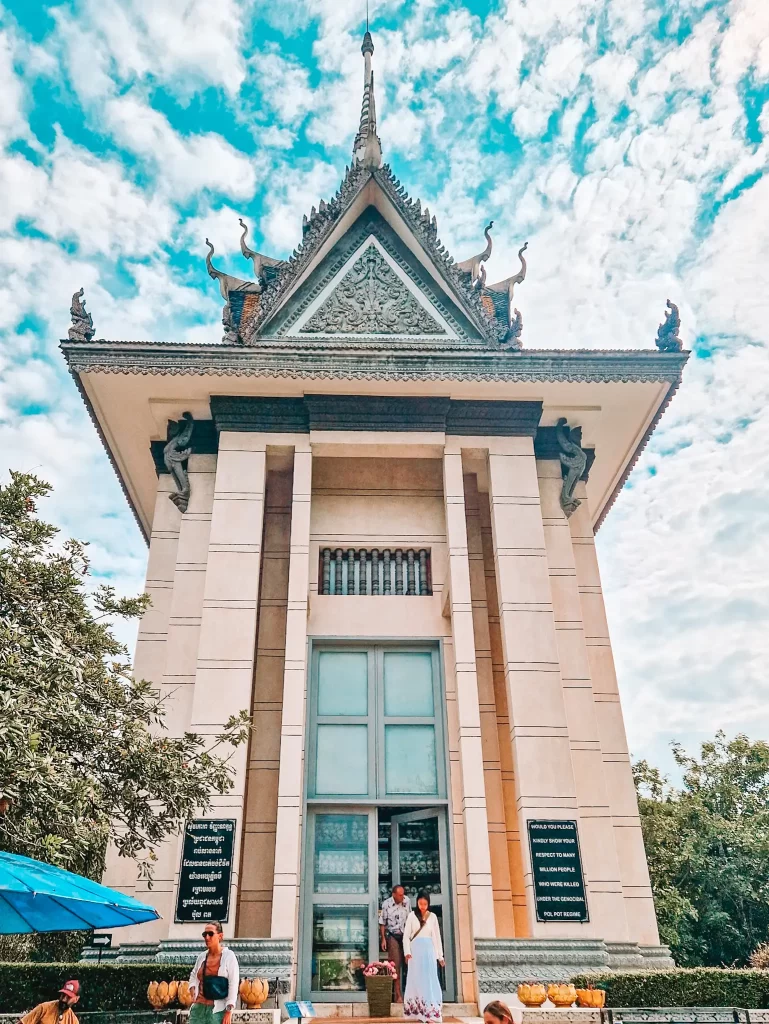
This is an extremely difficult visit. Both guided tours and the audio guide provide graphic details of the atrocities, including violence against children. Cambodia has not shied away from its past, and at Choeung Ek, human remains occasionally surface from the ground. The memorial also contains skulls and other body parts.
The centre is well set up and there are audio guides available. Choeung Ek is about 25 minutes drive from the centre of Phnom Penh. If you are not taking a guided tour, the best way to get there is via Grab Tuk-tuk or car.
Stop 2: Tuol Sleng Genocide Museum (S21)
Cost: $5
Trigger warnings:
- Descriptions of violence and torture
- Photos of dead bodies
Tuol Sleng Genocide Museum is the other monument the city that is a must-do to understand this devastating history.
Originally a school, Tuol Sleng was repurposed into a prison under the Khmer Rouge. It’s now a well run museum which documents the atrocities that took place there. Notably, the man who ran Tuol Sleng was one of the very few members of the Khmer Rouge who were actually prosecuted.
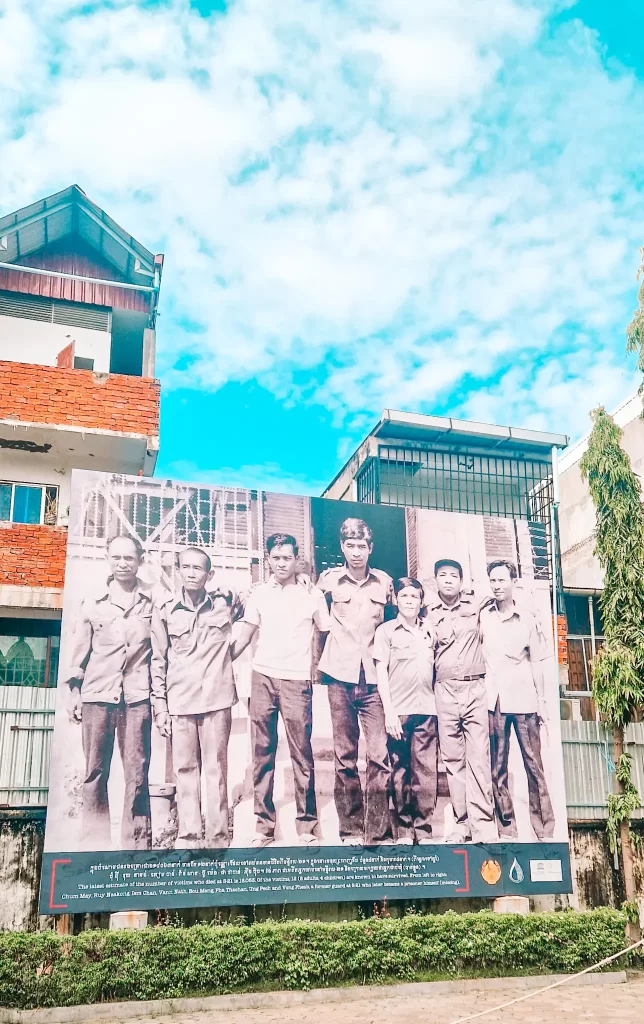
Tuol Sleng is not for the faint of heart. You’ll see and hear extensive evidence of torture, including photos of dead bodies, photos of the victims and the small cells they were imprisoned in. One of the most chilling aspects for me was seeing photos of the guards—many were boys between 10 and 15 years old, and many are still alive in Cambodia today.
Tuol Sleng is relatively central in Phnom Penh, and you will easily be able to organise a tuk-tuk or car if you wish to visit independently.
Guided tour v independent visits
I chose to take a guided tour for my visit, but many people choose to visit independently and use the audio guides.
For me, the benefit of having a guide was enormous:
- My guide gave us detailed context for this period of Cambodian history, including the previous French colonisation and the short period of democracy in between this and the Khmer Rouge. This really helped me to understand the political conditions which allowed the genocide to occur.
- He brought his own personal experience of the genocide to the tour. Throughout, he talked of the enduring impact on the Cambodian people, including family members that he lost during the genocide.
However, I’ve also met people travelling who preferred the audio guides:
- They found the audio guides detailed enough to provide the necessary historical context.
- Audio guides let you experience the sites at your own pace, without feeling rushed or needing to move too soon
If you want to take the guided tour, I used this Viator option, which I’d highly recommend.
Stop 3: Unwind and decompress
It’s likely that you’ll find the visits to Tuol Sleng and Choeung Ek very difficult and emotionally draining. I recommend setting aside some time after your visit to decompress. One way to do this is to go for a massage or spa treatment – there are many options for good, cheap massages in the tourist area of Phnom Penh.
Equally, if your hotel has a pool, this is a great time to sit by the water and escape the afternoon heat.
Stop 4: Take a river cruise
Once you’ve decompressed, it’s time to move on to the final activity for your 2 days in Phnom Penh.
A popular option in Phnom Penh is to take a river cruise down the Mekong at sunset. Many of these cruises come with open bars and are a great option to spend a couple of hours in the early evening.
Tickets are available online, at hotels, through tour agencies, and along the Mekong’s banks starting around 4 PM.
Frequently asked questions
Best time to visit Cambodia
Cambodia has a tropical climate with two main seasons: dry (October–April) and wet (May–September). The best time to visit is October–February, when temperatures are cooler and the landscape is lush from recent rains.
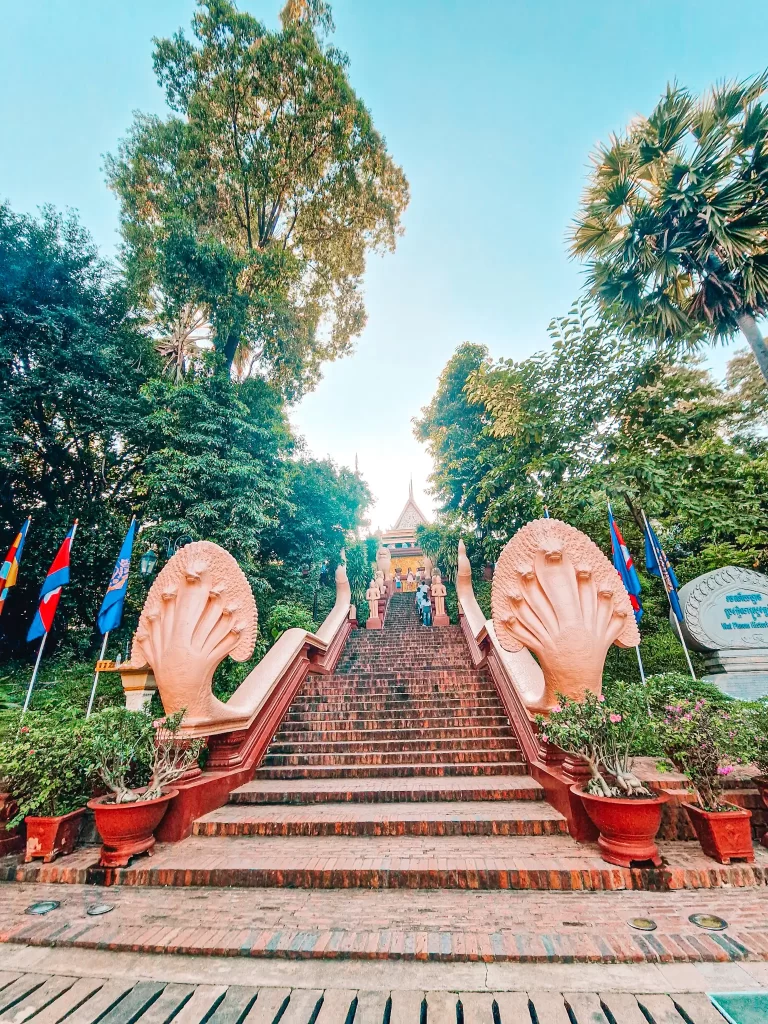
✔ Best months to visit: October & November (cool, green, and less crowded).
✔ Peak tourist season: December–February (cool, but busiest).
❌ Avoid: March–June (extremely hot) & August–September (heaviest rain).
Is Phnom Penh safe?
The biggest risk to tourists in Cambodia, as in much of Southeast Asia, is bag snatching and theft. The British Foreign, Commonwealth and Development Office (FCDO) warns that this is prevalent in tourist hotspots in Phnom Penh. Always keep your bag close, especially in tuk-tuks or when walking—hold it on the side away from the road to prevent snatching.
Phnom Penh is generally considered less safe than Siem Reap. Exercise caution, particularly at night. Make use of Grab to get you to and from your hotel if you’re outside the main tourist area by the river.
Practical tips for visiting Phnom Penh
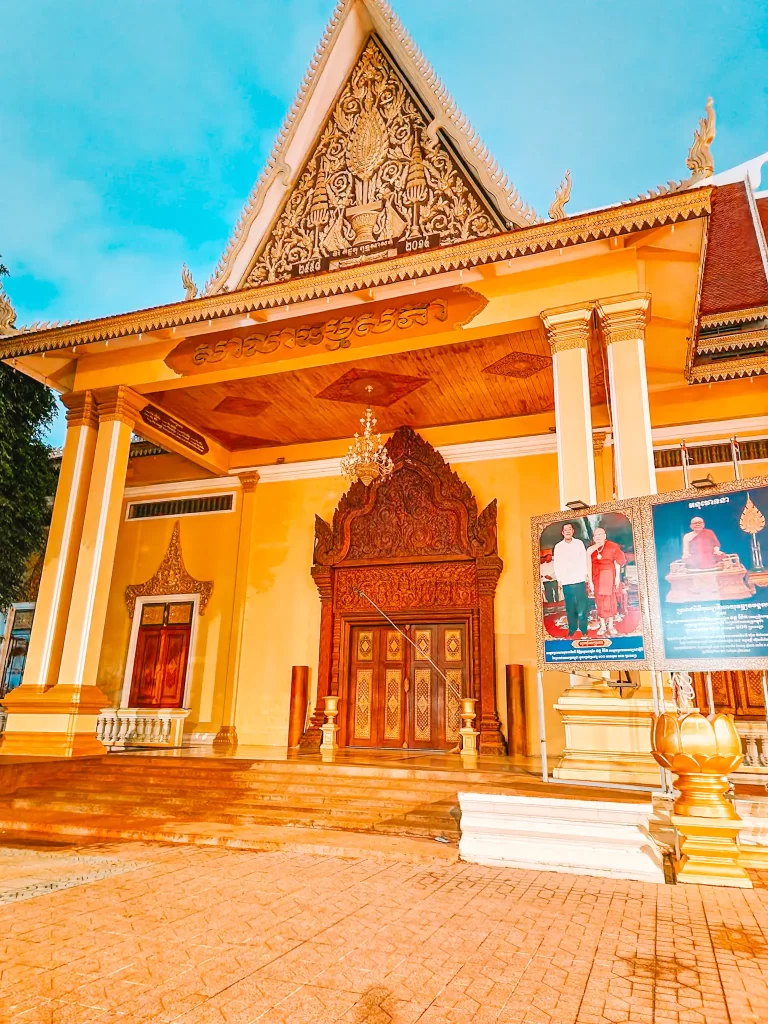
These are some practical tips that will make your life easier in Cambodia:
- Currency: confusingly, Cambodia uses both the US Dollar and Cambodian Riels, completely interchangeably. Be prepared to do a lot of maths while you’re in Phnom Penh! It is very common to pay in one currency and be given change in the other. To deal with this:
- Bring a mixture of Riel and Dollars
- Stay aware of the exchange rate
- Always check your change
- Using US Dollars: these must be pristine and won’t be accepted otherwise. Bring a purse or wallet that allows you to keep notes in mint condition. Do not accept damaged or worn US dollars as change—they may not be accepted elsewhere.
- ATMs: ATMs are easily accessible in Cambodia, as are money exchanges. There are ATMs in Phnom Penh and Siem Reap airports, as well as in the cities.
- Changing money: I prefer to use a card that doesn’t charge for withdrawals (for example, the Chase debit card or Halifax credit card in the UK). If you want to have money on you when you land rather than using an ATM, search for the best rates in your home country before you travel rather than changing at the airport. I never recommend changing money at an airport, as exchange rates will be much higher.
- Mosquitoes: Mosquitoes are common in Cambodia, especially during the rainy season! You can buy good (and delicious smelling) repellent very easily in Cambodia, but it won’t have DEET. If you really want DEET repellent, it’s best to bring this with you.
How to get to Phnom Penh
As a capital city, Phnom Penh is a transport hub, and you can arrive in a variety of different ways.
Air
Phnom Penh has a busy international airport that’s not too far from the main city. This is how I arrived, but I only accessed arrivals so I can’t say whether it has good departures facilities.
However, arriving into Phnom Penh airport was easy and immigration was relatively quick. If eligible, apply for an E-visa in advance to speed up the immigration process.
It was easy to get taxis or tuk-tuks from the airport into the centre of Phnom Penh. Like most airports in Cambodia, there is a dedicated Grab waiting area – just follow the signs. You can get a Grab car or tuk-tuk. As it was a reasonably long journey through traffic, and I had luggage, I opted for a car to avoid some of the pollution and have more space.
There were also a lot of tuk-tuks waiting outside – if you don’t want to use Grab, make sure to negotiate the price in advance.
Bus from within Cambodia
Cambodia has an extensive bus network that runs to all the major cities. The most common routes for travellers are from Siem Reap, Battambang or Sihanoukville (the gateway to Koh Rong and Koh Rong Samloem). Roads to major destinations in Cambodia are generally good, as there are a lot of new motorways being built.
Bus travel times from key destinations:
| Destination | Duration |
|---|---|
| Phnom Penh to Siem Reap | 5-6 hours |
| Phnom Penh to Battambang | 5 hours |
| Phnom Penh to Sihanoukville (for Koh Rong and Koh Rong Samloem) | 3-5 hours |
| Phnom Penh to Kampot | 3 hours |
| Phnom Penh to Kep | 4 hours |
Bus companies I used in Cambodia
After reading reviews and taking tips from other travellers, these are the bus companies I used while in Cambodia:
- Vireak Buntham – the biggest provider of buses in Cambodia, with extensive routes and times. Vireak Buntham offers different vehicle types—check before booking. I used their minivan, which was very comfortable, and a less comfortable mid-sized bus called a Coaster.
- Vireak Buntham VET Airbus – I also used Vireak Buntham’s new airbus to go from Phnom Penh to Battambang. This bus is available on routes into Phnom Penh including from Siem Reap. This new service is modeled after Vietnam’s famous VIP buses. The bus was serious luxury – like travelling business class. The hostess even brought me a coffee! Book in advance—they sell out quickly!
- Giant Ibis – a smaller company which offers certain routes, including luxury VIP buses on longer journeys. Giant Ibis made a point of saying on their website that they always have two drivers on board, and encourage drivers to drive slowly to promote safety.
Cambodian Trains
There is a rail network in Cambodia, originally set up by the French. From Phnom Penh, you can get trains to destinations such as Kampot, Sihanoukville and Battambang.
However, these trains tend to be slower than buses, and with sparse timetables. Unlike Vietnam’s famous overnight trains, they also don’t offer a high standard of luxury. Unless you particularly want the train experience, I would recommend taking the bus!
International Bus
It’s also possible to get a variety of international buses into Phnom Penh. The most common are probably from Ho Chi Minh City in Vietnam, or Bangkok in Thailand.
- Ho Chi Minh City to Phnom Penh is about 7 hours. While this isn’t the longest trip in South East Asia, it’s a good while if you’re uncomfortable. Research your bus type in advance, and if possible, take the Airbus or another bus that has 3 seats across instead of 4. Giant Ibis also run a VIP bus on this route.
- Bangkok to Phnom Penh is about 12 hours. Many options on 12Go Asia are minivans. From experience, I wouldn’t recommend a minivan for a 12-hour trip. Vireak Buntham offers the Airbus for this trip and this would be my choice.
- Laos to Phnom Penh: Vireak Buntham offers a new service from Pakse, Don Det and the gorgeous 4000 Islands, and even Vientiane. However, unless you don’t want to see Angkor Wat I think most people will stop off in Siem Reap before arriving in Phnom Penh.
How to get around in Phnom Penh
Getting around during your 2 days in Phnom Penh is easy and affordable. Grab is widely used, and you can quickly order both cars and tuk-tuks. Most tuk-tuks are small, two-person electric vehicles—convenient and eco-friendly. I felt like I was whizzing around the city.
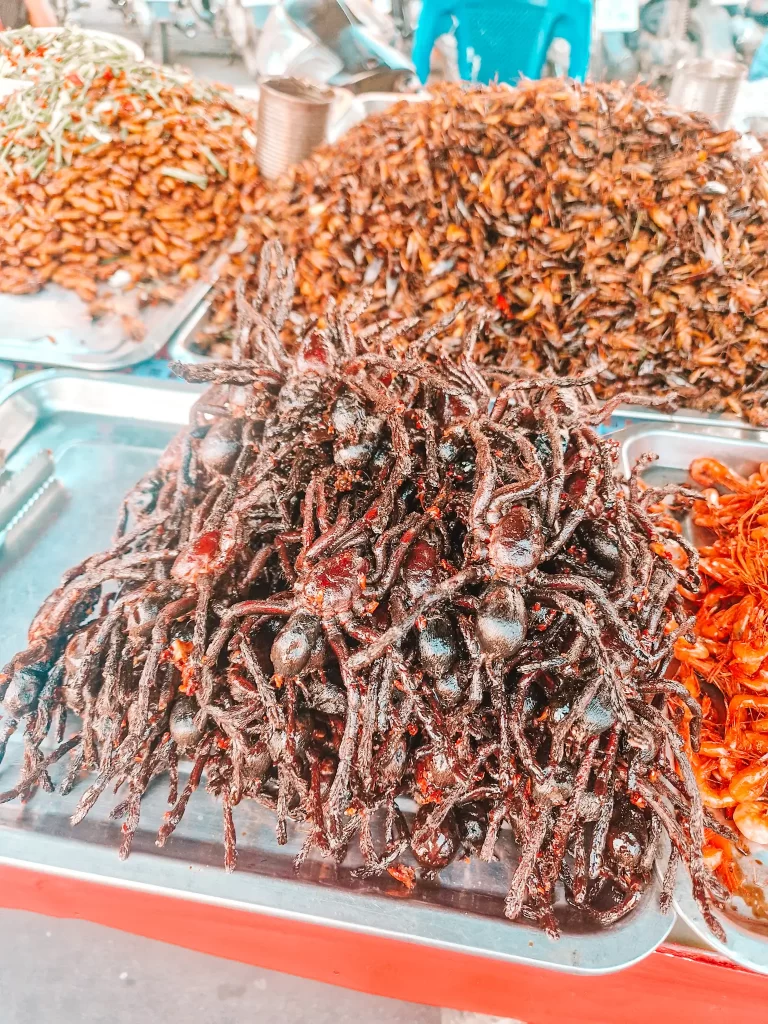
As with most of South East Asia, you can also find private tuk-tuks around, which tend to be the older kind. They congregate on street corners in busy areas, and outside bigger hotels. If using a traditional tuk-tuk, negotiate the fare before starting your ride.
Phnom Penh is also a reasonably easy city to walk around. A lot of the main tourist area is fairly small, and you can explore this area easily on foot.
Where to stay in Phnom Penh
Most hotels in Phnom Penh are located in the central tourist area, and this is a great place to stay. It gives you easy walking access to all the restaurants and bars in this area, as well as shops.
- Julieka’s Guest House – this is a great budget option, but beware that some rooms are really budget. Opposite the National Museum, the location couldn’t be better. My room was dark and basic, but clean and functional. I’d stay again.
- Pacific Hotel – the first couple of days I was in Phnom Penh I stayed in the Pacific Hotel, at the top end of my budget. I loved this place – for British readers, it was like a really good Premier Inn. Spotlessly clean, great bed linen, great lighting options in the room and a good breakfast. However, it’s not in the centre of the city, and there are no restaurants or shops nearby. If you stay here, you’ll need to take Grab Tuk-tuks to get to central Phnom Penh.
- Aquarius Hotel and Resort – I didn’t stay here, but during my research for a more upscale stay, this was my top choice. This is the hotel I ended up selecting. It has a rooftop infinity pool and gorgeous-looking rooms, as well as excellent reviews. If you’re looking for something higher end, this is the place for you.
Phnom Penh stays with you long after you leave. In just 2 days in Phnom Penh, you’ll witness Cambodia’s resilience, explore its royal past, and gain an unfiltered understanding of its darkest chapter. It may be an emotionally challenging city to visit, but it is also one of the most important. And beyond the weight of history, there’s a city that’s evolving—where food, culture, and daily life continue to thrive. If you’re debating whether Phnom Penh is worth visiting, the answer is yes. Not because it’s picture-perfect, but because it’s real, raw, and deeply significant.

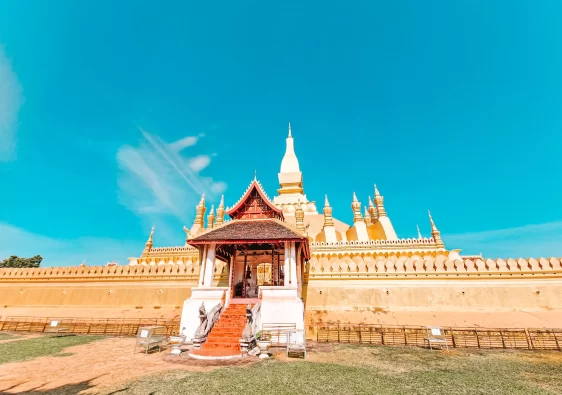
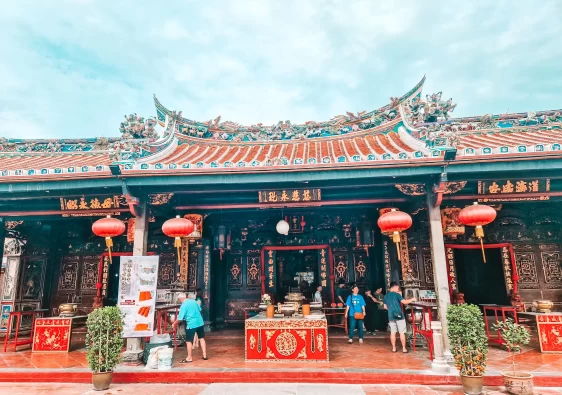
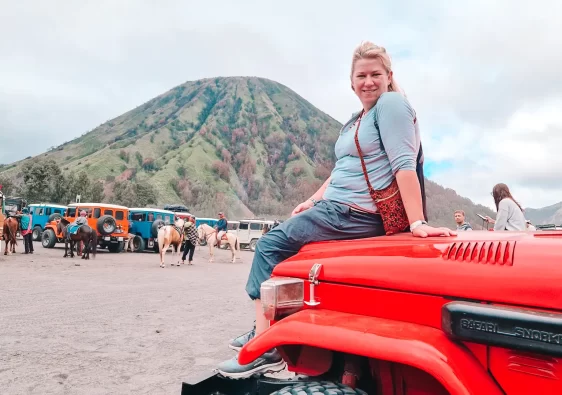
[…] to other capital cities in South East Asia? Check out my guides Phnom Penh – Everything you need to know to visit this historic city and Amazing things to do in Hanoi – how to make the most of this vibrant […]
Thank you for sharing your experience and tips on visiting Phnom Penh. I have traveled through parts of Asia but have yet to visit Cambodia. Your guide makes visiting Phnom Penh feel very doable, and I really liked that you tied in lighter activities and time to decompress alongside visits to the museums.
Thanks for the kind words! I would definitely add Cambodia to your SEA list, it’s a great country. And I can’t say enough about how important it is to decompress after vistiing the genocide sites while you’re there. It’s not just decompression, it’s time to process. Hope you have a great time if you make it there!
Awesome guide! Thanks for sharing!
Thank you!
I remember my first visit to Phnom Penh, I felt so ashamed I had never even heard of the Cambodia genocide. I also spent 2 days in Phnom Penh and they were some of the hardest but most rewarding days of my Southeast Asia backpacking trip.
I agree with all of this, it’s appalling how little we hear about it in the west. And its definitely an experience that’s really stayed with me as part of my travels.
Oof, the tarantula! 😉
Haha, I never saw a live one so you’re fine!
I have yet to visit Cambodia, but I will definitely make it a point to visit Phnom Penh when I do. When I go, I absolutely HAVE to visit the night market, although, if I’m honest, I don’t know if I’ll have the guts to try the spiders. Coconut based desserts, though? We’re on!
I didn’t try the tarantula either! But if you go, Martin’s tour is a great way to visit the nightmarket because he knows all the stallholders! (not on commission for Martin! Just thought his tour was absoulutely amazing.)
Phenom Penh and Cambodia has been on my bucket list for a while. I’m definitely including it on my next trip to South East Asia
I hope you get to go! I really loved it, I’m actually heading back for a week in about a month to go to Kampot.
I loved our time in Phnom Penh, there’s so much to do here and so much (sad) history to learn about.
It’s definitely a city for history lovers!